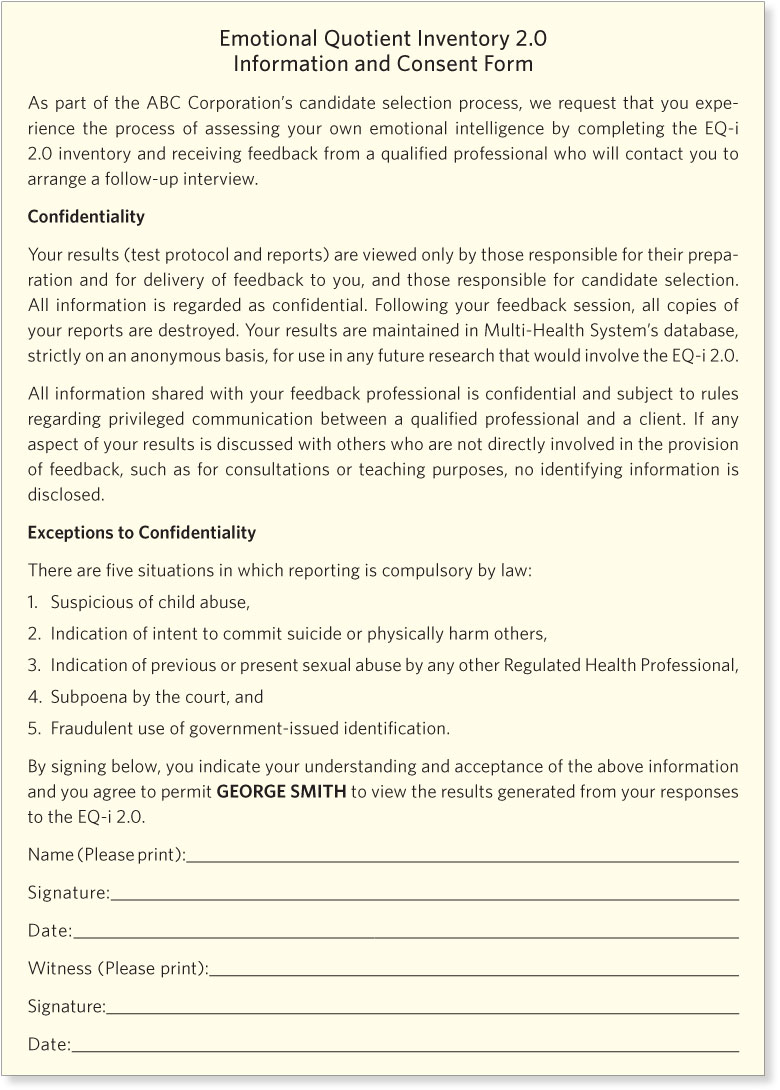Part II: Administering a Self-Report EQ-i 2.0
EQ-i 2.0 Setup and Scoring
Preparing Participants
Speaking with respondents before the administration is essential to completing a successful EQ-i 2.0 assessment. All individuals participating in the EQ-i 2.0 assessment process need to have an understanding of the purpose, process, and expectations of the assessment. The more individuals understand about why an EQ-i 2.0 assessment is being introduced and how the information will be used, the more likely participants will be to engage in taking the assessment openly and honestly.
This section discusses best practices for meeting with respondents one-on-one or as a group prior to administering the EQ-i 2.0.
Hosting a Pre-Assessment Interview
When assessment is not part of an organization’s culture, or when a coach is working to build an ongoing relationship with a client, a private interview can be particularly beneficial in setting the stage for the EQ-i 2.0 process. Consider the following topics for discussion.
- Discuss with your client the expected outcomes of the assessment – what do they want to get out of it?
- Discuss the reason why your client was selected to participate.
- Identify a number of EI competencies that are particularly important for success in your client’s position or current life circumstances.
- Discuss with the participant informed consent and their right to confidentiality. Explain where the data will be kept, and who will have access to the data.
- Discuss the importance of providing answers that are honest and reflect current functioning.
- Discuss with the participant how he or she will receive ongoing support and follow-up. Participants need clarification about what is expected of them after they receive their feedback.
The general approach to introducing the EQ-i 2.0 is to stress the positive, constructive, and beneficial aspects of the assessment. Encourage questions and attempt to answer them in a manner that will not bias their subsequent ratings.![]()
The above topics can be discussed in a group setting if time does not permit individual interviews. Please refer to Step 3: Gaining Buy-In in Planning the EQ-i 2.0 Assessment Process for additional group orientation guidelines.
Informed Consent and How to Obtain It
The following section outlines the process for obtaining informed consent. It is not the intention of this section to be all-encompassing or the final authority. It is recommended that any users of the EQ-i 2.0 or EQ 360 2.0 become familiar with the guidelines outlined by their respective national and/or regional governing body (e.g., American Psychological Association, Society for Industrial Organizational Psychologists, etc.).
The process of obtaining informed consent begins by explaining to the respondent the general purpose of the assessment, including the reason he or she is being asked to complete the EQ-i 2.0. In most settings, the respondent must be informed of any limits to confidentiality and what the administrator will do to ensure confidential information is protected.
The respondent must be instructed that he or she has the right to stop the assessment at any time for any reason (consistent with the ethical standard of “freedom to withdraw”), and made aware of the consequences of this choice and of any alternative options. Informed consent means that the respondent has agreed to complete the assessment without being forced to do so, and understands what the task involves (i.e., answering questions about one’s feelings and behaviors) and how the results will be used.
Confidentiality is often addressed as part of the informed consent discussion and should include information about protecting the privacy of respondents’ responses. The assessor/administrator must be honest about who will have access to the results of the assessment(s), and the purpose or goal for which the results will be used. The respondent should be informed about the measures that will be taken to keep the information confidential (e.g., printed reports will be stored in a locked file cabinet in a locked office). Assessors using the online administration option should visit www.mhs.com to access the MHS Security Policy, which includes information about the advanced security methods used by the EQ-i 2.0 Portal for the protection of sensitive and confidential data.
The respondent should be reminded why he or she was asked to complete the EQ-i 2.0, and when results and recommendations will be provided. The assessor should answer any questions and/or address any concerns that the respondent may have about the administration of the assessment.
Figure 5.3 provides a sample Informed Consent form, which can be used as a record of the participant’s consent when a physical signature is required.Figure 5.3. Sample Information and Consent Form
